Menus
- GS, Multistrada, Crosstourer, Super Adventure and Explorer
- 1000 points
- travel
- Country road
- Offroad
- Conclusion
- MOTORCYCLE overall result
- Price comparison of used travel enduros
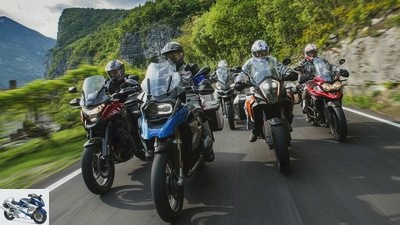
Rivas
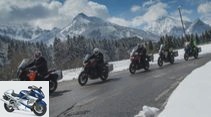
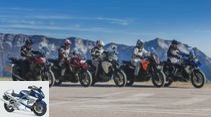
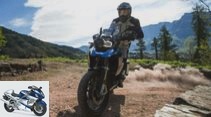
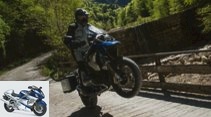
50 photos

Rivas
1/50
2017 travel enduro in comparison test.
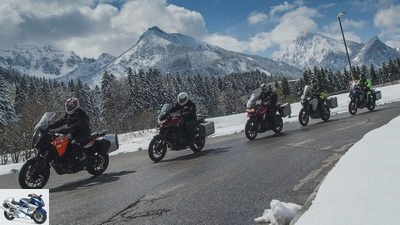
Rivas
2/50
BMW, Ducati, Honda, KTM and Triumph in the battle for control of the travel enduro segment.
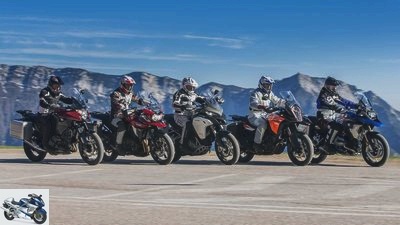
Rivas
3/50
So far, the R 1200 GS has been considered the universal ruler on the Olympus of the travel enduro segment.

Rivas
4/50
Inside by or outside by? The rally also benefits off-road from the now uniform technology (larger flywheel, torsion damper) of all Boxer models.
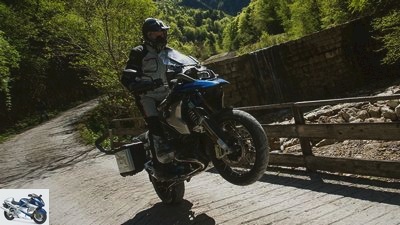
Rivas
5/50
2017 travel enduro in comparison test.
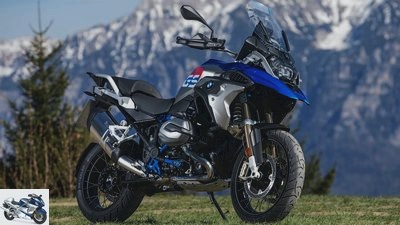
Rivas
6/50
2017 travel enduro in comparison test.
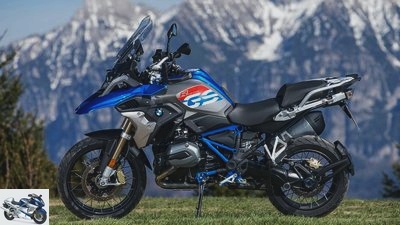
Rivas
7/50
2017 travel enduro bikes in a comparison test.
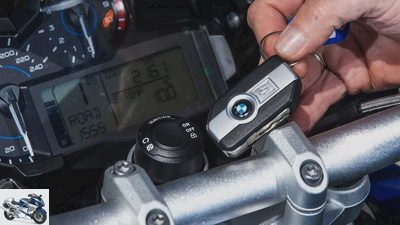
Rivas
8/50
The electronic wave sloshes on with high waves. Transponders replace the ignition key.
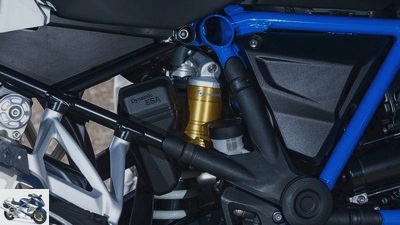
Rivas
9/50
Automatic level control – not only with BWM!
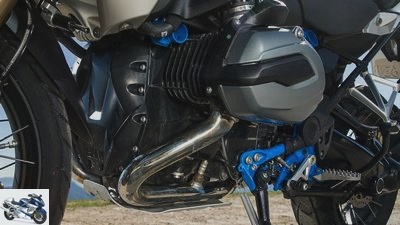
Rivas
10/50
2017 travel enduro bikes in a comparison test.
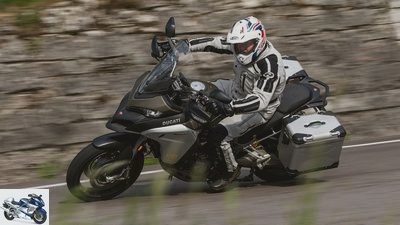
Rivas
11/50
Into the full: The enduro version of the Multistrada is clearly committed to off-road use.

Rivas
12/50
The off-road Ducati places the driver very upright thanks to the high handlebars.
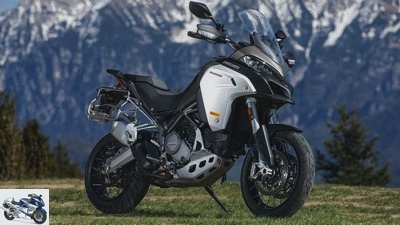
Rivas
13/50
2017 travel enduro in comparison test.
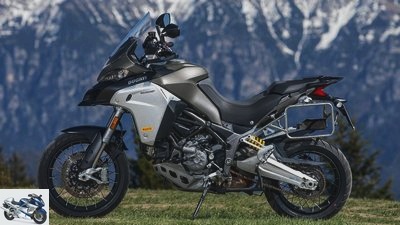
Rivas
14/50
2017 travel enduro in comparison test.
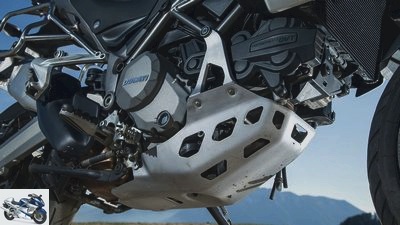
Rivas
15/50
Not to be overlooked: the powerful engine protection of the Ducati.
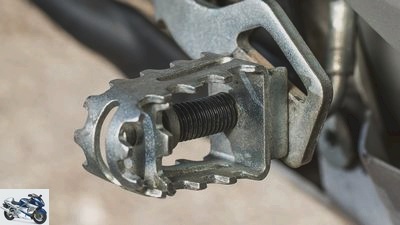
Rivas
16/50
The serrated brake lever can be turned for two step heights.
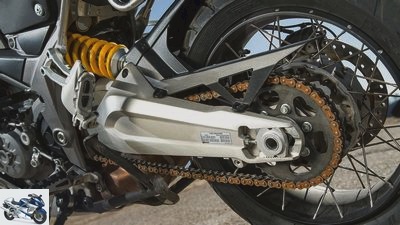
Rivas
17/50
Only the Enduro edition has a two-sided instead of a single-sided swing arm.
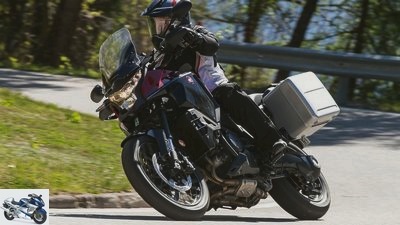
Rivas
18/50
2017 travel enduro in comparison test.

Rivas
19/50
2017 travel enduro in comparison test.
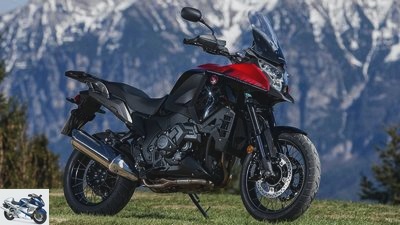
Rivas
20/50
Keep it simple: With the Crosstourer, Honda has implemented a decidedly user-friendly concept.
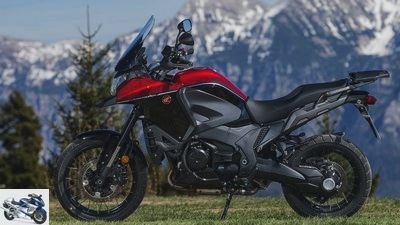
Rivas
21/50
2017 travel enduro in comparison test.
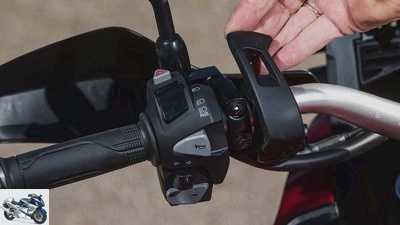
Rivas
22/50
The parking brake is due to the DCT (double clutch transmission).
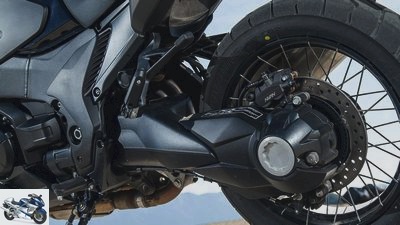
Rivas
23/50
The dual clutch transmission fits the Crosstourer like the easy-care cardan drive.
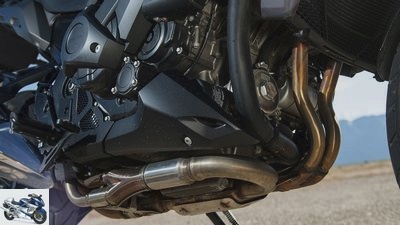
Rivas
24/50
The Crosstourer has little to do with off-road riding. A protective plate for the sensitive exhaust is not even available in the original range of accessories.
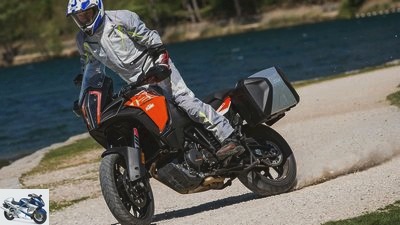
Rivas
25/50
Know-how: If a manufacturer knows how to build off-road motorbikes, it’s KTM.
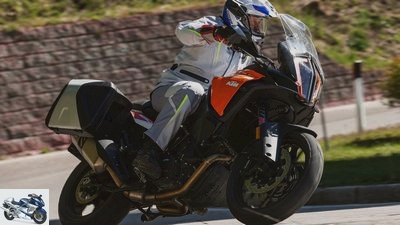
Rivas
26/50
2017 travel enduro bikes in a comparison test.
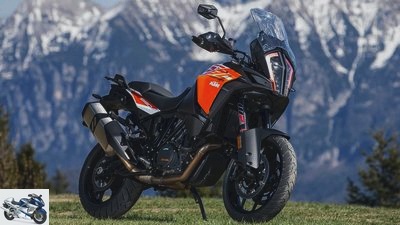
Rivas
27/50
2017 travel enduro in comparison test.

Rivas
28/50
2017 travel enduro in comparison test.

Rivas
29/50
With the display supplied by Bosch, KTM is setting a new standard. The monitor image is as large and as razor-sharp as a tablet.
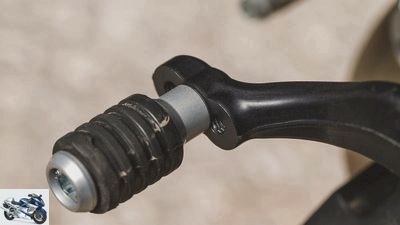
Rivas
30/50
The know-how of motorcycle construction is also documented in details such as the three-way adjustable gear lever knob.
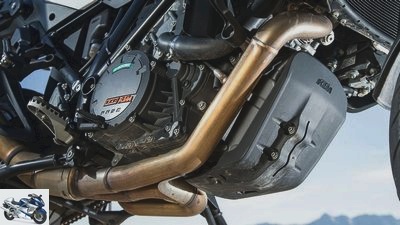
Rivas
31/50
Strange that the Austrian is being delivered without a standard engine guard.
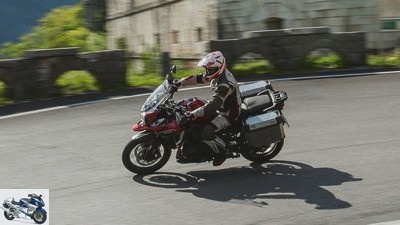
Rivas
32/50
Cuddly tiger: The adventure look is deceptive.
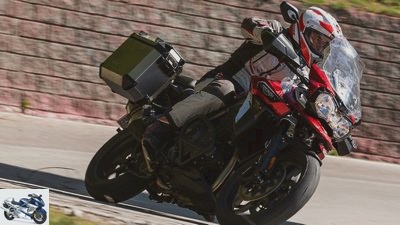
Rivas
33/50
2017 travel enduro bikes in a comparison test.

Rivas
34/50
2017 travel enduro in comparison test.
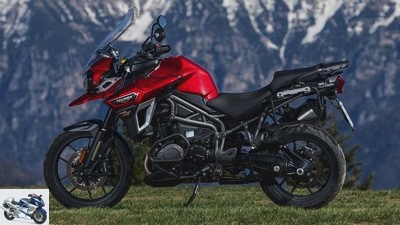
Rivas
35/50
2017 travel enduro in comparison test.

Rivas
36/50
The basic setup of the fork can be adjusted electronically.

Rivas
37/50
The electronics can be easily operated via the display after a bit of getting used to.
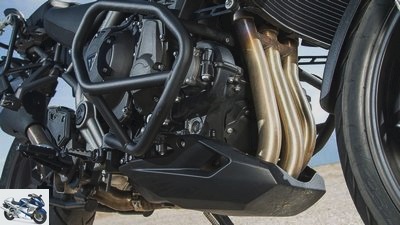
Rivas
38/50
The smooth and highly refined running three-cylinder engine defines the pleasant character of the Triumph.
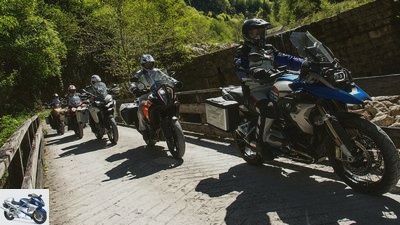
Rivas
39/50
2017 travel enduro in comparison test.
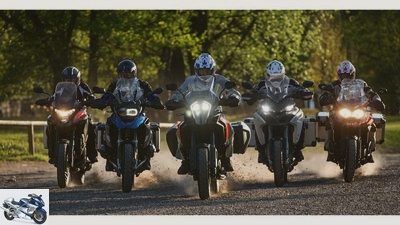
Rivas
40/50
2017 travel enduro in comparison test.
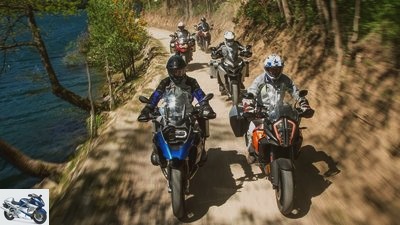
Rivas
41/50
2017 travel enduro in comparison test.

Rivas
42/50
2017 travel enduro bikes in a comparison test.
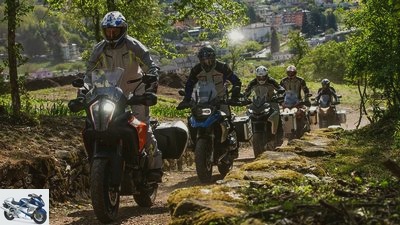
Rivas
43/50
2017 travel enduro in comparison test.
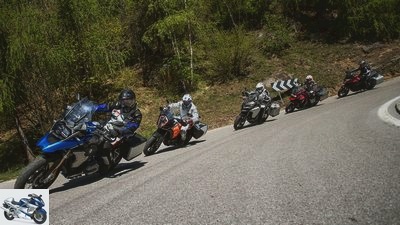
Rivas
44/50
2017 travel enduro in comparison test.
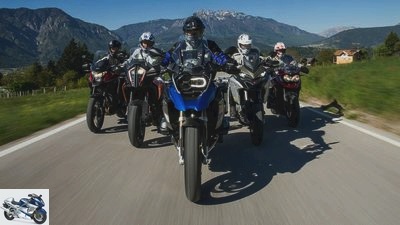
Rivas
45/50
2017 travel enduro bikes in a comparison test.
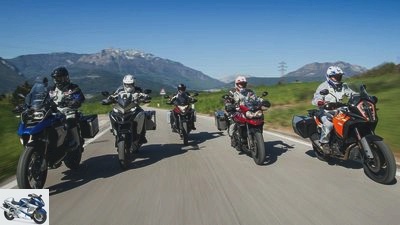
Rivas
46/50
2017 travel enduro in comparison test.
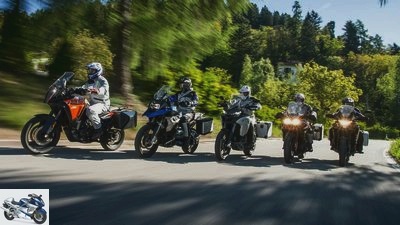
Rivas
47/50
2017 travel enduro bikes in a comparison test.

Rivas
48/50
2017 travel enduro in comparison test.
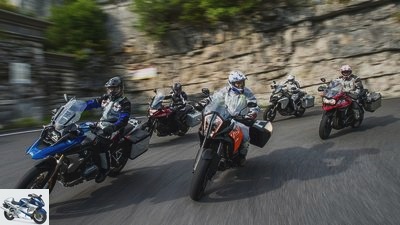
Rivas
49/50
2017 travel enduro in comparison test.
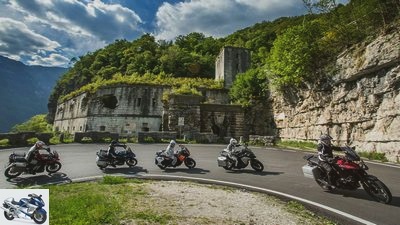
Rivas
50/50
2017 travel enduro in comparison test.
2017 travel enduro in comparison test
GS, Multistrada, Crosstourer, Super Adventure and Explorer
For years, the R 1200 GS has stood as the most universal ruler on the Olympus of the travel enduro segment. But the competition is working hard to change power. Can the new BMW R 1200 GS Rally extend its lead, or can it be pushed from the throne by Ducati Multistrada 1200 Enduro, Honda Crosstourer DCT, KTM 1290 Super Adventure S or Triumph Tiger Explorer XRt?
1000 points
S.is the result already determined before starting? No. The 1000-point rating is traditionally the basis of the MOTORRAD travel enduro comparison test.
Buy complete article
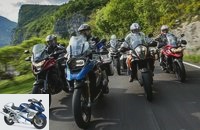
2017 travel enduro in comparison test
GS, Multistrada, Crosstourer, Super Adventure and Explorer
KTM embarked on the clean-up of the travel enduro line. After the end of the 1190, there are only two engine variants: In the Adventure the 1050 cm³ V2 (125 PS) throbbing, in the Super Adventure the 1301 cm³ propellant (160 PS). The Austrians also do without the previous 30-liter fuel drum in favor of moderate dimensions and install a 23-liter tank. However, there are no ambitious off-road intentions behind it. They are served by the R model of the Adventure. But with its 21/18 inch tires, it doesn’t fit into the test field, which is uniformly rolling on 19/17 inch wheels.
The Ducati Multistrada 1200 Enduro, which was introduced last year, is clearly aimed at a wider range of uses than before. 266 parts distinguish it from its basic edition. Two-sided swing arm, 30 millimeters longer suspension travel, 65 millimeters longer wheelbase, a shorter gear ratio, spoked wheels and – in contrast to the colleagues from BMW and KTM – a massive 30-liter tank are the cornerstones of the changes. At almost 23,000 euros, it is the most expensive in the field.
Triumph confuses Explorer fans with a somewhat confusing nomenclature. The abbreviations XR (Cross Roads) and XC (Cross Country) differentiate the model lines with spoke (XC) and cast rims (XR), which were also refreshed last year. The lowercase suffix – x or t – defines the equipment. To cut a long story short: The Tiger Explorer XRt has cast wheels and almost all accessories available for the three-cylinder.
Honda is shifting the focus on electronics. The ABS and traction control of the Crosstourer built since 2012 work without lean angle sensors. Instead, the role of the technology image bearer is taken over by the automatically shifting dual clutch transmission (DCT) built into the test motorcycle.
And who is missing? The Euro 4 homologated Yamaha XT 1200 Z Super Tenere will not be delivered until the end of May. The Aprilia Caponord 1200 Rally and the Moto Guzzi Stelvio are currently only being sold as Euro 3 models. And the Suzuki V-Strom 1000 lacks a bit of displacement and power. She will soon be messing with the 1090 KTM in MOTORRAD.
Back to the numbers: true to the more recent tradition in the large enduro comparison tests by MOTORRAD, the 1000-point rating (right) only serves as the basis for a more specific classification of the machines in the categories of travel, country roads and off-road. The total of 500 points are awarded according to stored criteria that are important for the respective evaluation. On the one hand, because the characters of the big ships can be worked out even more specifically. On the other hand, because the off-road qualities are not taken into account at all in the 1000-point evaluation. In the 1000-point table, the KTM 1290 Super Adventure S already caused a chair back. The Austrian overtook the BMW R 1200 GS Rallye (745 points) with 763 points. By the way: The KTM would have achieved this top position even against the basic GS (739 points) and the adventure version (747 points).
But does the lead remain if the points in the specific under-evaluations also add to the book? We will see – after many experiences, impressions and experiences. For the words behind the numbers.
travel
The fact that they take the first half of their designation seriously has ultimately given the travel enduros their triumphant advance. Far, fast, good – few categories implement this claim better than the two-wheeled multitools.
We don’t care if our colleagues look pityingly. It’s slept outside. There should already be snow in the Allgau. So what? Eagles have never hatched from soft eggs. A little later, the underground car park spits the travel enduro quintet out into the coolness. Nowadays it can be assumed that the machines started without any problems. The ignition keys are in retreat and are now called transponders. But they can accidentally be forgotten in the garage or their signal can be hacked by thieves. Sound old fashioned? The Honda and Triumph pilots will never feel excited about their pockets for the digital ignition keys later.
Stop-and-go traffic on the arterial roads. Every centimeter counts when snaking between the sheet metal snakes. Especially with suitcases. Even after all these years, no luggage system can hold a candle to BMW’s Vario system, which increases the volume by almost 50 percent using a simple lever. Even when extended, the hard shells nestle close to the rear of the car and – together with the Honda cases – are still the narrowest at 95 centimeters wide. It’s good that professional stunt driver Jo is sitting on the KTM and still leaves a finger-wide gap between the 104 centimeter wide containers and the expensive metallic paints with a sure eye. In the past, the Austrians had their problems with suitcases anyway. The high-speed commuting with a load cost the 1190 adventure first its image and then even its career. But now everything is fine. Flexible case holders prevent the 1290 and its little sister, the 1090 Adventure, from swinging open. MOTORRAD tried it out some time ago. The KTM troop has always handled the operation without a suitcase well. As with the BMW and Honda, the brackets disappear inconspicuously. In contrast to the intrusive cane braids of the aluminum cases from Ducati and Triumph. After all, their adventure boxes, which can be opened at the top, are much more convenient to fill than the side loaders of the rest of the trio
We turn onto the autobahn. The gray flakes waft through the air like cotton wool. Only far back on the horizon does a dark gray wall of clouds announce worse. Let reason prevail or take advantage of the likely short opportunity of the hour? Jo gives the answer, shoots past on the KTM as if stung by a tarantula. He was forgiven. Even in the domesticated version with a larger flywheel mass and narrower channels, the V2 of the KTM turns the trainer on more intensely than any other engine in this quintet. It is exciting to feel the kick with which the Adventure reignites even at 200 km / h. Also because the times of booming eddies behind the windshield of the 1190 predecessor model are a thing of the past. The height of the windshield of the 1290 Adventure, which can only be adjusted with both hands, is more aerodynamically sophisticated and protects the pilot well. Kati has retained the ready-to-race feeling. The handlebars are slightly cranked and comparatively flat, the seat is taut. And despite full electrification, she doesn’t want to patronize him. Motor mappings, damping adjustment, load status and the coordination of all driving aids can be set separately from one another via the menu. Comparatively uncomplicated on top of that. The horse seems to run away with Jo for just a moment. With a top speed of 250 km / h – despite the case only with very slight stirring – the KTM leaves us standing.
The Ducati keeps up with the frenzy longest. The Italian runs 240 km / h, remains bolt-stable – and yet feels completely different. The handlebar, which rises up to a height of just under ten centimeters, determines the seating position. The Ducatist therefore resides downright upright. At least that irritates those who expect a more sporty orientation from Bologna. Comfort dominates in other ways too. The narrow window that can be adjusted with one hand provides excellent protection from the storm, the seat is comfortable, the suspension is sensitive, and the range of 600 kilometers made possible by the huge 30-liter tank is sensational. Those who are satisfied with the preconfigured settings of the four driving modes will quickly find the right setting. Most will gladly do without the complicated fine adjustment of damping and engine tuning.
And maybe squinting at the Honda. In the field of electronic upgrading, the Crosstourer appears like an open-air museum. And that in a positive sense. The suspension is easily adjusted in height and inclination with a handwheel and screwdriver, the disc with a simple hand lever, there are no different driving modes. And because the automatically shifting dual clutch transmission (DCT) also relieves the load, the Honda driver has nothing else to do than concentrate on driving. Certainly not the worst option. It’s just a shame that the coordination of the spring elements did not go well, which Honda can respond to cross joints with the shortest spring travel of the five. Nevertheless, it is astonishing that the V4 is the weakest propellant in the field with 102 hp measured at the rear wheel. Especially when you know that the identical four-cylinder in the VFR 1200 F, which is no longer sold, made a good 40 hp more.
If you want to read how the R 1200 GS rally is traveling, you can do the following: Simply browse through the volume-filling driving reports of the basic GS, the effects of the two centimeters longer spring travel, the smoothing hand of the torsion damper and the automatic one Add the level control of the Dynamic ESA – and the result is ready for the Bavarian woman. In plain language: The electronics are child’s play and intuitive to use, the suspension automatically detects the load using spring travel sensors and responds sensitively. In addition, the seat is cute, the windshield caring and the power with measured 126 hp is sufficient. On top of that, the maintenance-free cardan drive makes friends – just like that of the Honda and the Triumph. In addition, the Bavarian is not only the most economical on the MOTORRAD consumption round, but also on the high-speed insert. We will refuel 6.6 liters with her after the first 100 kilometers driven. The competition needs 6.8 liters (KTM and Triumph) or 7.0 liters (Ducati and Honda).
Speaking of triumph. It quickly becomes clear that the Englishwoman feels at home on the tour. With the lowest vibration motor, the well-functioning level control of the shock absorber or the huge, electrically adjustable windshield, the British girl pulls her aces out of her sleeve on the track. It is easier to zap through the modes than its predecessor, and even with the fixed, stable aluminum cases, the Explorer, which used to tend to commute, stays on course. As a Pullman Express, with these qualities it overtakes the rest of the quartet.
It’s snowing harder. It only takes a few kilometers for the flakes to gather together to form a blanket of snow. The traction control lights flash excitedly, steering and braking is hardly possible. The rear-view mirrors are filled by the truck’s grille. We get queasy. We turn into a parking lot, wait for the clearing vehicle. Because we know that spring is coming 200 kilometers further south.
Country road
The goal is the goal. Finding curves that enjoy almost deserted mountain pass roads in the preseason – that’s what motorcycling is all about. Not only after a long day of arrival. But then even more so.
It’s eight in the morning. The sun’s rays squint flat over the motorbikes in the open garage. Only the chirping of birds interrupts the silence. The scene looks downright cheesy. But no doubt, we arrived in spring. In Levico Terme. But not only the wonderful weather makes up for the frosty journey. The climbs from the Brenta Valley, such as the legendary Kaiserjagerweg, meander up the mountain slopes just a few kilometers away, and are tempting to do motorized morning exercise.
Waiting for what? The way to the first climbing tour is hardly enough to warm up the engines. So go ahead. Again it is the Honda that is independent. It’s amazing how much the automatic control of the DCT influences the personality of the Crosstourer. We saved ourselves the early upshifting D-mode on the alpine playground, just click on the S-gear. It takes a while for the left foot and clutch hand to understand that they have a break. But then you start to appreciate the new driving experience. It is amazing what resources switching-free driving frees up in the attic of the upper room. Without having to pay attention to the correct switching point before and after the curve or the smoothing finger on the clutch lever when changing loads, things can be left to run more freely. Maybe just as well. Because with 292 kilograms – ten of which are due to the DCT transmission – the 76-degree V4 has to maneuver the heaviest machine on the test field upwards, and gratefully accepts the extra momentum. In general, it is surprising how the unusual mixture of the highest weight, the narrowest rear tire (150 mm), the flatter steering angle (62 degrees) and the longest wheelbase (1595 mm) ultimately does not result in a particularly manageable, but emphatically neutral driving behavior. It’s just a shame that the comparatively shortest suspension travel (145/146 mm) reacts allergically to dirty asphalt, rocking the bike and making the biker feel some potholes impolite. Ultimately, the cross-tourer finds her strength in her neutrality, but she has to admit defeat to the pointed characters of her colleagues.
Even if only barely. For as proud as the Triumph may have turned off the autobahn and the highways, the Briton is being purified again in the small and small of the country lanes. Above all, the front, which feels heavy to the touch, gives a feeling of indolence, making the 286 kilo XRt appear unwieldy and stiff in the asphalt slalom. Although the designers try to counteract with the steepest steering angle (66.9 degrees), the Explorer cannot hide the mass of its mighty triplet. Whereby just this one rehabilitates at every turn. Even at the lowest engine speeds (just under 1000 rpm!), The 1215 trident accelerates as smoothly as butter and pushes through the speed range completely stress-free. Only the Honda is closer to shift-free driving. In general, the famous three-cylinder dominates the driving experience on the Triumph. When he whistles his little song, the somewhat dull front brake and the slightly diffuse feedback are forgotten. The latter is largely due to the fork, which is tightly damped in all riding modes and which works its way into its spring deflection with rapidly successive waves. To compensate, the front end swallows potholes or lonely asphalt wrinkles. At the rear, the level control automatically adjusts the ride height to different loads. That works fine. Nevertheless, the same applies to the Triumph as to the Honda. Against the distinctive characters of the top three, the chubby lady from Hinckley remains behind. Despite their famous triplets.
Ducati is in a similar situation. While the Italian had benefited from her ultra-relaxed seating position, the amazing suspension comfort and the successful wind protection on the track, she had to duck away in the bend barrage. By far the greatest dimensions of the five and the said upright, inactive sitting posture make the Duc search for the right line more often in the network of rural roads. Again and again, the Multistrada driver catches himself leaning his upper body forward in the bends in order to bring additional weight to the front and to receive more feedback from the front end. The suspension set-up coupled with the driving modes offers a wide range of options. If you take it easy, you can ride comfortably over the frost in the touring mode, which works with little damping. Anyone who gears up has to forego some comfort with the sport mode, which is much tighter at the rear, but it brings more calm to the chassis. In the brisk line, however, the V2, which is actually potent with measured 148 PS, has to give up a bit. Despite the high performance offer, the torque dip between 4000 and 6000 rpm is clearly noticeable when exiting a curve. The Duc driver intuitively keeps the 90-degree V2 equipped with variable valve control above this speed limit, often driving one gear lower than necessary. This not only creates unnecessary basic aggression, but also makes the Desmo-Twin, which is already borderline loud, sound even louder over the Brenta Valley.
The KTM proves that noise has absolutely nothing to do with performance. With a sonorous, but reasonably muffled carpet of sound, the Austrian, measured at 154 hp, collects initial sympathy points. Wait, weren’t you promised 160 hp? Right. With the generous range of services offered by the V2, the six missing horses may not be decisive for the war, but a small image dent remains. Nevertheless: As with the Triumph, it is precisely the propellant that puts its stamp on the driving experience. As awake as if he had pulled in a pallet of cans from the corporate sponsor Red Bull, the engine with the largest displacement with 1301 cm³ hangs on the gas, pushes ahead with unrivaled power and makes every sprint between the turns an experience. If you want. If not, the 75-degree Vau chugs up thanks to the new resonator chambers in the intake tract that dampen the gas vibrations. None of the five engines creates a wider range between impulsive and well-groomed appearance. Especially since the Adventure performs this skillful balancing act on the chassis too. The cushioning can be adjusted from record-breaking comfortable to sporty and firm and responds better than any of its predecessors did. Only the clacking of the semi-active damping element in the fork is still annoying. And because the more moderate dimensions compared to the previous Super Adventure, the lowest weight at 245 kilos, the formidable brakes and the neutral handling round off the overall package, the Austrian succeeds in catching up with the previous queen of the country road, the BMW GS.
Even though the Bavarian is still making it difficult for KTM. Above all, with an almost unbelievably fluffy handiness – given the dimensions of the rally – the GS succeeds in waving the competition into the ground. She has an answer to every question. Steering precision: the best. Suspension comfort: the best. Stability: the best. And since she – like all GS models – got the revised gearshift mechanism and the torsion damper implanted, her drive train has also behaved well. Anyone who has got used to the somewhat decoupled driving experience through the Telelever front will soon gain unabashed trust. Against this polished background, nobody really missed the Dynamic ESA with automatic level compensation. Nevertheless, the imperceptibly working regulation is pleasant. Ultimately, the relationship between the BMW and the KTM is only leveled out by the lower punch of the measured 126 hp of the boxer, the gearbox, which is less smooth to shift despite the shift assistant, the more snappy brakes or the eleven kilos higher weight. The fact that the Bavarian-Austrian duo are now at the top together after driving up the pass is not only the correct decision in terms of points, but also subjectively.
Let’s wave a little lively. Tomorrow’s going to be exhausting.
Offroad
Only with their off-road qualities do the travel enduros complete their universal claim. Are these skills also being used? Who knows? But it’s good to know that you could turn if you wanted to.
Southern Europe and great freedom – this combination has long since relativized reality. Off-road trips beyond the Alps are just as illegal as in this country. Only the gray area of tolerance may be a little more pronounced. Hotelier Sergio Lorenzini has taken precautions to get us permission from the municipality to legally use the paths in the area around Levico Terme.
It doesn’t take a single meter of gravel under the wheels to find out about your individual off-road ambitions. The Honda feels least drawn to the bumpy terrain. The highest weight, the shortest spring travel and the fact that an engine protection plate is not even offered in the original accessories catalog document: Not with me. Especially when the unprotected exhaust snake is maneuvered over such rough rock as in the Valle di Sella. Too bad. For inexperienced drivers, starting off on steep driveways would be easy with the DCT. But which novice dares to venture into the demanding terrain with a 17,000 euro motorcycle? Just.
The Triumph is not the right partner for the off-road excursion, simply because of its model name. However, it is not just the cast rims instead of the spoke rims that prevent the XRt from being predestined for gravel splatter. The front section, which already feels heavy on the road, really troubles the Englishwoman in soft terrain. In bends with loose ground, the lady likes to push the front wheel straight ahead. With her many pounds, she generally struggles in the greenery, always lets her rider keep an eye out for the lowest-risk trail. After all, it is not only true for the British woman: what leans here, falls. It’s actually a shame, because with the traction control that is practically regulated in enduro mode and the suspension, which is tuned for terrain with sufficient reserves, the engine could even show its strengths here. The gentle three-cylinder makes it easy to use the power even on gravel.
The Ducati answers questions about its off-road affinity through its body language. None of the five are as clearly committed to the dusty element as the Multistrada Enduro. Engine protection, jagged footrests and brake levers emphasize how seriously the Italian takes the excursion into the countryside. The extremely tightly tuned damping in Enduro mode also fits into the picture. And finally it becomes clear why the Italian model planners mounted the handlebars so unusually high. As soon as the pilot stops, the ergonomics fit. Handles and levers lie naturally in the hands, and even the huge fuel drum allows you to close your knees. The Ducatist rumbles ambitiously up and down the path with astonishingly large suspension reserves. He only has to suffer when things get tricky. Then the Ducati rider is also troubled by the stately weight, the clutch, which is strenuous to pull in the long run, and the borderline dimensions of this Multistrada.
What the KTM uses to just overtake the Ducati. Because the R version (21/18 inch wheelset, spoked wheels, conventional suspension) may actually be predestined for rough use, but the S version also straddles the open flank of the Duc. The KTM is 32 kilos lighter and, with its 23-liter tank, more manageable in proportion than its Italian colleague. And because the clutch, brake and other control elements can be operated playfully and the suspension can also be electronically and individually adjusted to the adversities, the KTM has the tip of its nose. However, the motorized scout should add 272 euros to the Adventure tariff for an urgently needed engine protection plate.
Which, by the way, is even more expensive at BMW at 335 euros. But only by the way. Because, like on the journey and on the country road, the qualities of the GS are also well known off-road. Whereby the rally adds another briquette in this regard. The two centimeters longer spring travel and the somewhat harder springs actually give it a bit more reserves. Sports people can even saddle up. With a simple push of a button, the Dynamic ESA pretensions the shock absorber’s spring to the maximum, raising the rear by up to five centimeters. Even with quickly traversed angular gullies, the rally does not break through, at least at the back. In these situations, however, the comparatively soft front must be relieved with an accelerator. Much more important, however, is that the GS can still expand its real strength with both the torsion damper and the 950 gram larger flywheel from the Adventure. The boxer plows up the slopes like a diesel and chugs through the tight bends even in trial style without jerking. And because the rally combines these advantages with moderate dimensions (20- instead of 30-liter tank), it is not only on the bumpy ascent from the Sella valley that it becomes the new boss in general terms.
Is that enough to turn things around after losing power in the 1000-point ranking? The total is added up at the end – right opposite.
Conclusion
What happens if the MOTORRAD 1000-point evaluation turns into a 1500-point evaluation? First, you know more precisely in which area the strengths and weaknesses of the individual machines lie. And secondly, the off-road criteria not included in the 1000-point evaluation are included in the assessment. This is a sensible and important extension for those traveling enduros with universal demands. In the case of this comparison, the overall rating also underpins the result of the 1000-point rating. In plain language: The sensation that arose at the beginning has been confirmed after many kilometers of motorway, country road and riding off-road. After many years of reign in the travel enduro segment, the BMW R 1200 GS falls from its throne. The new queen in adventure land is called the KTM 1290 Super Adventure S..
MOTORCYCLE overall result
1. KTM 1290 Super Adventure S.
It’s done. With a powerful engine, neutral handling and – above all – good manners, the KTM takes over the reins of travel enduro bikes.
2nd BMW R 1200 GS rally
The GS has not lost any of its qualities. Great engine and first-class chassis convince. Only: the better is the enemy of the good.
3. Ducati Multistrada 1200 Enduro
The off-road-savvy Ducati also cuts a fine figure on the road. Comfort and suitability for travel are top, but their dimensions are enormous.
4. Triumph Tiger Explorer XRt
For its engine and comfort, it hugs the world. But apart from the commodity locomotion, the British woman is too sedate and front-heavy.
5. Honda Crosstourer DCT
DCT transmission and simple electronics make the Honda user-friendly. But high weight and moderate suspension slow them down in all criteria.
Price comparison of used travel enduros
1000PS marketplace app
There are many used travel enduros on the used market.
Used travel enduros are in abundance on the used market. Many of the touring motorcycles are already equipped with accessories such as pannier systems, but there are also some standard models. Here is an overview of the travel enduros from this comparison: used travel enduros in Germany.
Related articles
-
Comparison test: three travel enduros in comparison
Comparison test: Travel enduros from Ducati, KTM and BMW Three travel enduros in comparison With four different driving modes – Touring, Sport, Urban …
-
Comparison test Ducati 996 S, Honda CBR 900 RR, Triumph Daytona 955i
PhotoGargolov comparison test Ducati 996 S, Honda CBR 900 RR, Triumph Daytona 955i Strategy games Four wins? Or would you rather be quick with three? …
-
Comparison test BMW K 1200 RS against Ducati 944 ST2 against Honda VFR
Comparative test BMW K 1200 RS against Ducati 944 ST2 against Honda VFR Three for all cases Three motorcycles, three different concepts, one claim: As …
-
35 pictures 1/35 BMW S 1000 R, Ducati Monster 1200 S, KTM 1290 Super Duke R and Triumph Speed Triple R in comparison …
-
Comparison test of 1000 travel enduros
Gargolov 1000cc travel enduros in comparison test Four wanderlust on two wheels In issue 14/2017 MOTORRAD compares the four travel enduros Ducati …
-
Comparison test Ducati 900 SS against Honda VTR 1000 against Laverda 750 S Formula
Comparison test Ducati 900 SS against Honda VTR 1000 against Laverda 750 S Formula Who dares, the twint Brand new and already in the big comparison test. The Ducati …
-
Comparison test of adventure travel enduros
markus-jahn.com 25 pictures markus-jahn.com 1/25 With a larger front wheel and off-road optics, Aprilia gives the Caponord in the rally version a …
-
BMW R 1200 R, Triumph Speed Triple and Honda CB 1000 R in comparison test
Bilski 48 pictures Bilski 1/48 Triumph Speed Triple. Bilski 2/48 curve artist. As is typical for Honda, the Honda CB 1000 R also makes it easy for its driver. Thick…
-
Comparison test BMW R 1200 GS Adventure, Ducati Multistrada 1200 Enduro, KTM 1190 Adventure R.
Tanja O’Kelly 37 pictures mio-fotografie.de 1/37 A comparison test of a different kind with the large enduro bikes BMW R 1200 GS Adventure, Ducati Multistrada 1200 …
-
BMW R 1200 GS Rallye and Honda Africa Twin in comparison test
factstudio.de 19 pictures fact 1/19 With the “Rallye” -GS BMW underlines the “Enduro” behind the “Reise”. Honda did this with the Africa Twin from …